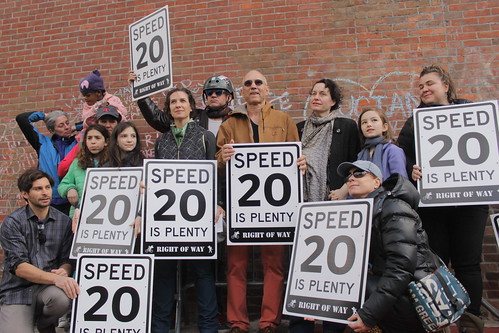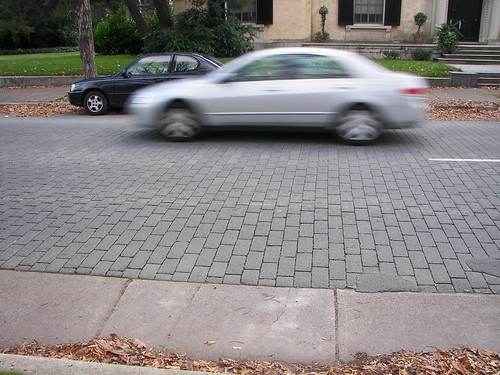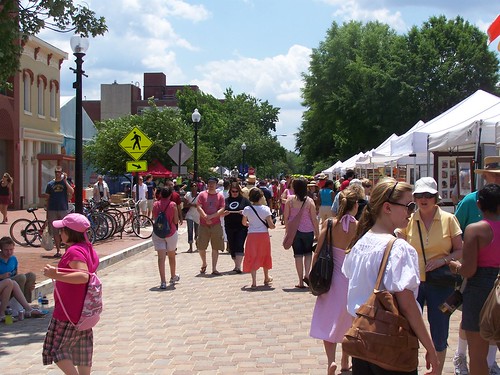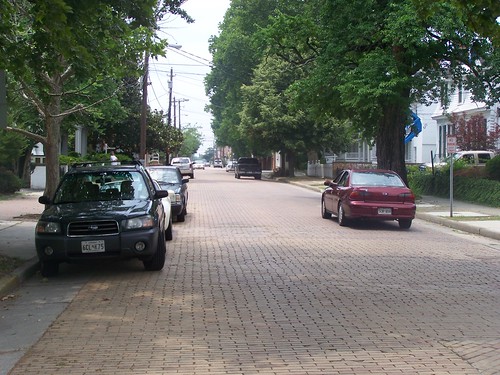The plight of pedestrians

Flickr photo by Liz Patek. "Twenty is Plenty For Us," is an advocacy initiative in the UK promoting lower speed limits to promote pedestrian safety.
For all the same kinds of reasons that transportation policy "disrespects" cyclists vis-a-vis motor vehicles because of a failure to have differentiated transportation policies and practices that are appropriate for sustainable transportation/cities and towns versus the policies we have which almost uniformly favor motor vehicles, pedestrians are dis-served by transportation policy also.
A good example of this is an ad by the Greater Washington Board of Trade which promotes traffic signal coordination across the jurisdictions, rather than expansion of transit--and transit, especially heavy rail transit, provides communities especially places like DC and Arlington County, clear competitive advantages over those places where automobile traffic dominates. The ad is a good symbol of the BOT's priorities...
Traffic regulations and metropolitan transportation policy favor motor vehicles, even in cities, where walking is often the predominate mode.
See "After six injuries in three days, police and bike advocates urge safety on Arundel roads" and "Engineering environments for pedestrian safety" from the Baltimore Sun, "Changing Skyline: Pedestrian safety is becoming a focus" from the Philadelphia Inquirer, and "Maryland to lower speed limit, expand speed cameras on troubled stretch of Route 1" from the Washington Post.
I write about this a lot, but since pedestrians still get killed, it's worth repeating.
1. Cars are engineered to go very fast.
2. Roads are designed, regardless of context, to allow cars to be driven at high speeds.
3. In places where pedestrians dominate, even when posted speeds are reduced, cars are still capable of being driven at high speeds and road engineering allows this.
4. So pedestrians die.
It's a form of what I call "designing conflict in," where the conditions are created through planning, design, and engineering to create problems instead of solve them.
That's why I recommend the "radical" step of re-engineering pavements in cities and towns, especially in commercial districts and around civic assets such as schools, parks, and libraries and other places where pedestrians predominate, so that road materials better match land context conditions for walking. Streets adjacent to college campuses, like the section of Route 1 in College Park, Maryland, adjacent to the University of Maryland, is another obvious place where pavement materials need to be chosen in a manner that is congruent with the land use context there.
The Smart Transportation Guidebook is has a good discussion about this broad issue, although it doesn't make the conceptual jump to include pavement types within a toolbox of choices.
And a good example of how to do this by expanding the use of asphalt block or other types of pavers, such as how Monument Avenue in Richmond is paved. The pavement provides visual, aural, and physical cues that motor vehicle operators should drive slower and they do.
I didn't realize that in the 1960s the intent was to asphalt over the pavement on Monument Avenue, but a neighborhood activist, Helen Marie Taylor, "faced down" the paving machines, and this motivated a group of Richmonders to support her, and the plans to pave over the street were dashed ("To Preserve and Protect," Style Weekly).
Another strategy is to reduce the legal operating speeds for motor vehicles in cities generally and in neighborhoods specifically. I was thinking about this a few months ago when I paused to walk across the street on my block, to wait for a car to go by.
I realized that I was deferring to the motor vehicle, even though my street is 100% residential, when the motor vehicles should be deferring to the pedestrian. Just as bicyclists should be deferring to pedestrians, riding more slowly on sidewalks than the speed at which pedestrians can walk.
Graz, Austria pioneered systematic reduction in motor vehicle speed limits in the early 1990s, changing all their speed limits to either 30 kph or 50 kph (50 kph is approximately 31 mph). More recently, New York City has create "Neighborhood Slow Zones" for residential streets, where the posted speed limit is 20 mph.
The standard speed limit on NYC streets is 30 mph. In DC it is 25 mph while in the old days on residential streets it was 15 mph. Under the Gray Administration, speed limits have been increased, in favor of motor vehicles, on many residentially-serving arterials.
Monument Avenue, Richmond

7th Street SE in front of Eastern Market, Washington, DC

South Carolina Avenue SE, Washington, DC

High Street (in brick), Cambridge, Maryland

Neighborhood Slow Zone signage, Bronx, New York City. (Image from Councilmember Melissa Mark-Viverito, District 8)
Labels: bicycle and pedestrian planning, car culture and automobility, pedestrian safety, traffic engineering, traffic safety and enforcement, transportation planning, urban design/placemaking





8 Comments:
Pedestrians are terrorists who get in the way of drivers. The statistics are clear on the extent to which pedestrians terrorize society and inflict harm on society: over 40,000 people are killed in walking accidents in the US each year and people walking spew tons of pollution into atmosphere, giving children asthma and impairing the lung health of thousands. And don't get me started on bicyclists and all of the externalities they impose on the rest of society. And the noise created by both pedestrians and bicyclists makes cities very unpleasant places.
you need to make sure that Courtland Milloy knows what's up.
2. Speaking of noise, I was in a meeting a few weeks ago when a person commented about the noise that will come from the new streetcars, because streetcars (running on electricity) are noisy.
A couple of us countered. In fact, just the weekend before I was at the Nat. Capital Trolley Museum and we rode on the Blackpool "boat" streetcar dating to the 1930s. I was amazed at how relatively quiet it was.
The big problem with "streetcars" and light rail is how loud the warning bells can be. I haven't been to Minneapolis for awhile, but in my experience theirs were by far the worst in terms of noise.
But I was just on the Metrolink in Southern California (railroad) and I was impressed with how relatively quiet their "bells" were. I guess it's because a lot of their line goes through communities and they have regulations against railroad horns.
3. Anyway, I think a big benefit of streetcars (and trolleybuses) is their comparative quietness compared to traditional buses. Even the CNG buses are pretty loud.
actually it is the LACK of noise that is a bit alarming- you might not hear a streetcar until it is on top of you !!! I cannot get the old people around Capitol Hill who are rabidly against streetcars- it is as though they have never been overseas and seen how good they are. They are obsessed with the idea that we are getting exactly what used to operate on DC's streets- IOW the streetcars that broke down every so often because of the underground cable system. The old people need to back off of this one and take it easy and let progress have its way. Streetcars are better than buses !!!
I don't think anyone can get through to Milloy - he is thoroughly insulated by his sinecure at the Post and has no interest in opposing views. (Or in actually doing research for his columns, he's been phoning it in for years. It must be nice.)
Electric streetcars and trams are indeed much quieter than trucks and buses and even cars. I would even say that they are exponentially quieter. The modern ones are so quiet that they almost glide by. I agree that the bells are a bit noisy, but to me that is a much more pleasant sound than the roar of an internal combustion engine. I'll gladly take a city full of the sound of streetcar bells over a city full of roaring trucks, buses and cars! (For example, a restaurant one block from my office downtown has set up outdoor dining on H Street NW. It is usually sparsely occupied. Fro good reason. H Street NW has heavy, almost constant bus traffic. Who the hell wants to eat lunch outside at that location with all the buses and cars roaring by?)
But streetcar/rail opponents are a lot like Milloy. They don't want to be confused by the facts. I imagine that many of them are the kind of people who, if they travel to Europe, take taxis when they are in Amsterdam or Vienna and then complain about how expensive those cities are. Never mind that a multiday transit pass in either city probably costs less than two taxi rides.
... you must work close to Suzanne. Her office is kitty corner from that Cuban restaurant at 9th and H that you are probably talking about. Whenever I meet her there, we typically comment about what a bad experience that must be.
(Although it's an issue other places too, like 8th St. SE.)
2. Good point about taxis etc. in Amsterdam.
Part of the problem is that people aren't very experienced using transit anymore.
Obviously, if you use it here, you can go anywhere else and figure out how to use it.
E.g., we'd know if we're going to London that it's far cheaper to get an Oyster card and we'd make a point of doing so before traveling.
But it's tough for newbies, especially with language issues, and if there isn't good "transit wayfinding" which mostly there isn't.
I wrote a post a long time about about integrating heritage trolley planning into DC streetcar planning, in part for heritage interpretation, but also modeling "best practice" transit practice to visitors, so they could go advocate for better transit service back home.
... but it doesn't help that Metrorail is the most expensive center city heavy rail service in the US. A foursome traveling throughout the city would spend a lot of money.
Some cities offer a group pass. We have our day pass, at $14.50. While the day pass for MUNI in SF is about the same, the weekly pass is $29 and you can get it as part of the CityPass.
3. I've ended up giving directions to people on the NYC Subway and explaining to an area resident how to use the UTA system and that where she wanted to go was within the free transit zone.
She asked me about other systems and I said once you are pretty familiar with one system you can figure out how to use other ones when you travel...
Interestingly, when C. Milloy lived on Capitol Hill, for awhile he lived in a "new construction" rowhouse on the north side of the 800 block of Constitution Ave. NE. I am not sure if the buildings date to the 1980s or 1990s.
its funny how Milloy claims to represent "native Washingtonians" or is allied with those as such. He is the farthest from this. My grandmom used to take me on long bus rides all thru DC as a kid and she was totally transit oriented. It was simple and the best way for her- she did not own a car. I got used to doing this early. She would take streetcars her whole life and knew all of them well. It is so sad that our heritage streetcars were destroyed for the cars. Now we are attmepting to put them back in. Grandma used to take the streetcar from Anacostia to the Hill across the old 11th street bridge- and now days the people claiming to represent "historic DC" are going to fight tooth and nail to prevent our HISTORIC 8th street streetcars from returning. I foressee the CHRS as mounting a sustained attack on any 8th street line. These people are total a-holes. I know you have allied your interests with them in the past Richard- but they are NIMBYs and hate 99 percent of what you stand for.
Sadly you are probably right.
Post a Comment
<< Home